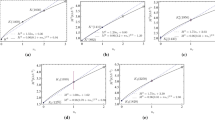Summary
We employ chiral symmetry in quark and in hadron language to show why theCP-conserving KL-KS mass difference Δm LS is about one-half of the KS total decay rate Γs
Similar content being viewed by others
References
Particle Data Group (J. J. Hernandez et al.):Phys. Lett. B,239, 1 (1990).
R. E. Karlsen andM. D. Scadron: submitted for publication toNuovo Cimento A.
P. Pascual andR. Tarrach:Phys. Lett. B,87, 64 (1979);M. D. Scadron:Phys. Lett. B,95, 123 (1980).
See,e.g.,M. D. Scadron:Rep. Prog. Phys.,44, 213 (1981);G. Eilam andM. D. Scadron:Phys. Rev. D,31, 2263 (1985).
S. Glashow, J. Iliopoulos andL. Maiani (GIM):Phys. Rev. D,2, 1285 (1970).
V. Elias, D. G. McKeon andM. D. Scadron:Can. J. Phys.,68, 1330 (1990).
M. D. Scadron andV. Elias: University of Western Ontario preprint (1992).
M. K. Gaillard andB. W. Lee:Phys. Rev. D,10, 897 (1974).
R. E. Karlsen andM. D. Scadron:Mod. Phys. Lett. A,6, 543 (1991).
The absolute square of the (wide) σ propagator in (15a) has been rationalized because Γτ≈m{τ}.
A σ(600) can be inferred from (18c) when one inputs the four fermion nonstrange scalar-meson massm σNS=2m qk form qk≈320 MeV. SeeY. Nambu andG. Jona-Lasinio:Phys. Rev.,122, 345 (1961);R. Delbourgo andM. D. Scadron:Phys. Rev. Lett.,48, 379 (1982);V. Elias andM. D. Scadron:Phys. Rev. Lett.,53, 1129 (1984).
Mixing angles ϕ in (17) relative to the quark basis are defined from mixing angles θ relative to the singlet-octetU(3) basis as ϕ=θ+tg-1√2 where tg-1√2≈54.7°. See,e.g.,M. D. Scadron:Phys. Rev. D,29, 2076 (1984) andA. Bramon andM. D. Scadron:Phys. Lett. B,234, 346 (1990) for the estimates ϕP≈41° and ϕS≈20°.
The inability to transform away the off-diagonal self-energy Σsd in the basis with strong eigenstates was discussed inR. Delbourgo andM. D. Scadron:Lett. Nuovo Cimento,44, 193 (1985) (see p. 196);A. Le Yaouanc, L. Oliver, O. Péne andJ. C. Raynal:Phys. Lett. B,182, 383 (1986); (see p. 386);R. E. Karlsen, W. H. Ryan andM. D. Scadron:Phys. Rev. D,43, 157 (1991) (see p. 161).
S. Weinberg:Phys. Rev. D,8, 605 (1973);Phys. Rev. Lett.,31, 494 (1973).
Author information
Authors and Affiliations
Additional information
The authors of this paper have agreed to not receive the proofs for correction.
Rights and permissions
About this article
Cite this article
Karlsen, R.E., Scadron, M.D. Chiral pole model and nonleptonic weak interactions. Nuov Cim A 106, 237–244 (1993). https://doi.org/10.1007/BF02800066
Received:
Accepted:
Published:
Issue Date:
DOI: https://doi.org/10.1007/BF02800066




